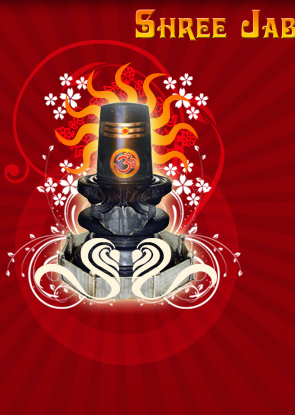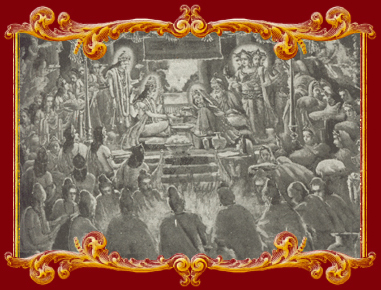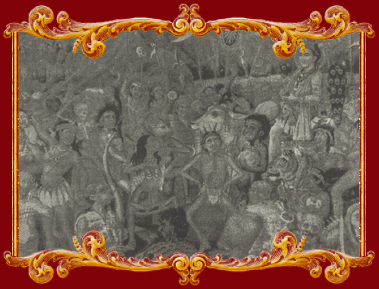
![]()
When Shivaratri is celebrated:
Auspicious festival of Mahashivaratri falls on the 13th or the 14th night of the new moon during Krishna Paksha in the Hindu month of Phalgun. The Sanskrit term, Krishna Paksha means the period of waning moon or the dark fortnight and Phalguna corresponds to the month of February - March in English Calendar. Shivaratri Festival is celebrated on a moonless night.
According to Hindu mythology, Shivaratri or 'Shiva's Great Night' symbolizes the wedding day of Lord Shiva and Mata Parvati. Many however, believe, Shivaratri is the night when Lord Shiva performed the Tandava Nritya - the dance of primordial creation, preservation and destruction. Celebrating the festival in a customary manner, devotees give a ritual bath to the Lingam with the panchagavya - milk, sour milk, butter and dung. Celebrations of Shivaratri Festival mainly take place at night. Devotees of Lord Shiva throng Shiva temples across the country and spend 'the Night of Lord Shiva' by chanting verses and hymns in praise of the Lord. The festival holds special meaning for the ladies. They pray to Mata Parvati also called 'Gaura', the giver of 'suhag' for good husbands, marital bliss and a long and prosperous married life.
On a Shivratri day, Shiva temples are thronged by devotees, mainly women, who come to perform the traditional Shivalinga pooja and seek blessings from the God. At times there is so much rush in the temples that devotees have to wait for their turn to observe pooja. Devotees of Lord Shiva observe the Shivaratri Festival by following the prescribed rituals with sincerity and devotion. All through the day, devotees abstain from eating food and break their fast only the next morning, after the nightlong worship. Ritual baths of Shivalinga in the numerous Shiva temples by Shiva worshipper, mainly women, is another significant feature of Shivratri customs and traditions. Devotees strongly believe that ritual worship of Lord Shiva on the auspicious day of Shivaratri absolves them of past sins and they are blessed with Moksha.
Shivaratri Rituals:
Following the rituals prescribed in the Shiva Purana, every three hours, Shivalingam is given a special bath with milk, yoghurt, honey, sandalwood paste and rose water. Puja, meditation and chanting of 'Om Namah Shivaya' accompany the ritual bath. Following the bath, vermilion paste is applied on the linga. Traditionally, leaves of a forest tree Aegle marmelos (bilwa, maredu, wood apple) are used for Shiva puja. Thereafter, Bilwa leaves, which have to be a stalk with three leaves, is kept on top of the Shivalinga. Ber or jujube fruit is a special offering to the god on this day. Beetle leaves are also offered by some. Some also offer bilwa leaves in the belief that the Goddess Lakshmi resides in them. Others believe it is offered for its cooling effects on the hot-tempered deity. Many devotees also decorate the linga with flowers and garlands and offer incense sticks and fruit.
According to the Shiva Purana, there is a special significance of the six essential puja items used in the Shiva worship.
Bathing of Shivalinga with water, milk and honey and wood apple or bel leaves added to it, represents purification of the soul.
The vermilion paste applied on the linga after the ritual bath represents virtue. Offering of fruits symbolizes longevity and gratification of desires. Burning of incense sticks yields wealth.
The lighting of the lamp symbolizes attainment of knowledge. Offering of betel leaves marks satisfaction with worldly pleasures.
Worship of Lord Shiva continues all through the night on Shivaratri Festival. Devotees stay awake all night and spend the night in Shiva temples in worship of Lord Shiva. Singing of hymns and verses in praise and devotion of Lord Shiva besides the intense chanting of Om Namah Shivay, the mantra that is said free people from all their sins, continue through the night on Shivaratri.
Special worship of Shiva by priests continues through the nightlong prayer vigil. During this ritual worship, Lord Shiva is offered special food made from the fruits of the season, root vegetables and coconuts. Those observing the Shivaratri Fast break their fast the next morning by consuming the prasad offered to Shiva.
Shivaratri Pooja has been given tremendous significance in Hindu mythology. It is said that ritual worship of Lord Shiva on a Shivaratri day pleases Lord Shiva the most. Devotees further believe that by pleasing Lord Shankara on the auspicious Shivaratri day, a person is absolved of past sins and is blessed with Moksha or salvation.
Benifits of Shivaratri Puja:
According to Shiva Purana, sincere worship of Lord Shiva yields merits including spiritual growth for the devotees. It also provides extensive details on the right way to perform Shivratri Puja.
Shiva Purana further says that performing abhisheka of Shiva Linga with six different dravyas including milk, yoghurt, honey, ghee, sugar and water while chanting Sri Rudram, Chamakam and Dasa Shanthi pleases Lord Shiva the most. According to the mythology, each of these dravya used in the abhisheka blesses a unique quality:
Milk is for the blessing of purity and piousness.
Yogurt is for prosperity and progeny.
Honey is for sweet speech.
Ghee is for victory.
Sugar is for happiness.
Water is for purity.
Besides, worship of Lord Shiva on Shivratri is also considered to be extremely beneficial for women. While, married women pray to Shiva for the well being of their husbands and sons, unmarried women pray for a husband like Shiva, who is considered to be the ideal husband.
Tradition of Drinking Thandai:
Since Lord Shiva is regarded as an ascetic god, Maha Shivratri is very popular with ascetics. Thandai, a drink made with bhang (cannabis), almonds, and milk, is essentially drunk by the devout on the day as cannabis is said to have been very dear to Shiva.
Fast on the day of Shivratri:
Shivaratri Fast is considered to be the most important fast for the devotees of Lord Shiva. Shiva Purana goes on to say that if a devotee observes Shivaratri Vrata with sincerity, pure devotion and love he is blessed with the divine grace of Lord Shiva. Every year devotees observe Maha Shivaratri fast with devotion and sincerity. Though many go on a diet of fruits and milk, some do not consume even a drop of water all through the day and night of Shivaratri Festival.
Benefits of Mahashivratri Vrat:
According to Hindu mythology, observance of mahashivratri Vrat with discipline helps a devotee to control the two great natural forces that afflict a man, rajas guna (the quality of passionate activity) and tamas guna (the quality of inertia). When a devotee spends an entire day in the Feet of Lord and worships with sincerity, his motion is controlled and evils like lust, anger and jealousy, born of Rajas are ignored and subdued. Besides, when a devotee observes vigil throughout the night (jaagran) he manages to conquer the evils of Tamas Guna too. It has also been mentioned that when a devotee observes a round of worship every three hours, the Shivaratri Vrata becomes perfect.
Devotees of Lord Shiva believe consider Shivratri fast to be extremely auspicious and rate it equal or more than performing an Ashwamedha Yagna. Some believe that a devotee who observes a Shivaratri Fast with sincerity and utters the name of Lord Shiva with perfect devotion is absolved from all sins. Such a devotee reaches the abode of Lord Shiva and lives there happily. He is also liberated from the cycle of birth and death.
Shiv-Sati Vivaah:
In the absence of Sati, the condition of Shivji was becoming very peculiar. He used to remember SATI day and night and used to discuss about her only. While dying SATI had made a resolution that she would take birth at King of Mountain Himalaya's palace and would re-marry Shiva. Whether Jagdamba's resolution can go in vain. She took birth in same palace and she was called Paarvati. When she became young her parents started looking a match for her. One day "Naarad Muni" suddenly reached to the palace of King Himalaya and after seeing the girl, he told only Lord Shiva is the perfect match for her. Knowing there daughter is literally SATI and has taken birth in there home they became very happy.
One day suddenly the anxious SHIVA in absence of Sati went for Tapasya in the same state. Hearing this, King Himalaya along with his daughter went to Shiva and requested that he should take the service of her daughter. In starting Shiva hesitated but later on seeing the Bhakti (devotion) of Paarvati he agreed. There after Paarvati daily cleaned the space where Shiva sat for Tapasya and tried to keep in mind each and every wish of Lord Shiva. Despite of the fact that Paarvati was very young and beautiful, Lord Shiva was always devoted in his Tapasya.

On the other hand a devil name Taarak was disturbing Gods a lot. Knowing the fact that only Shiva-Paarvati's son only can kill him, they were making efforts so that they can marry. To make Shiva attract towards Paarvati they requested Kaamdev to help them, But Kaamdev also failed in this mission in fact he was finished (Bhasma) by Shiva and then Shiva returned to Kailash.
Paarvati was disappointed being refrained not able to do service of Shiva but she decided to do Tap. Her mother advised her not to do so but she didn't listen to her and that's why her name become UMA (means don't do Tapasya). She left her home and started doing Tapasya at the same peak where Shiva used to. From then onwards the place is called "Gauri Shikhar". Then she spent her 1st year by eating only fruit, that's why she was called Arpene. In this way she did Tapasya for 3000 years.
At last Lord Shiva became soft hearted. For taking the test of Paarvati HE first sent Seven Rishies (Saints) to her and followed them in Vatu vesh. After complete verification and satisfaction He saw that Paarvati was fully devoted and dedicated towards him and couldn't resist HIMSELF from coming in His original looking. HE suddenly came in HIS original form and granted wish (Vardaan) of Parigarahn to Paarvati and became invisible. Seeing her Tap (labour) becoming successful SHE returned home and told the whole thing to HER Parents. After hearing this, there was no limit to the parents happiness that her daughter's Tap (Labour) gave her the desired result (was fruitful). On the other hand Shiva sent Saptarishis to King Himalaya with marriage proposal and in this way marriage auspicious date was also fixed. Through Naaradji, Shiva invited all the Gods with hounour and on the decided date Brahma, Vishnu, Indra and all Gods along with there group reached Kailash. Here Himalaya had made gala arrangements for the marriage and Shiva also reached with Baarat (marriage procession) to this auspicious marriage.

At first/in beginning seeing the VIKAT form of Shiva and his companions Bhut Pret (devils army) Maina (Paarvati's mother) became scared and started hesitation in her daughter marriage. But when she saw, Shiva's RUP of 16 yrs which attracts crores of Kaamdev she forgot everything and alongwith her daughter she gave her soul also to Shiva. The marriage was performed very joyously and king Himalaya made Kanyadaan. Lord Vishnu and other Gods presented different gifts to them. Brahmaji perform/monitered the marriage ritually. Then every body left home happily.